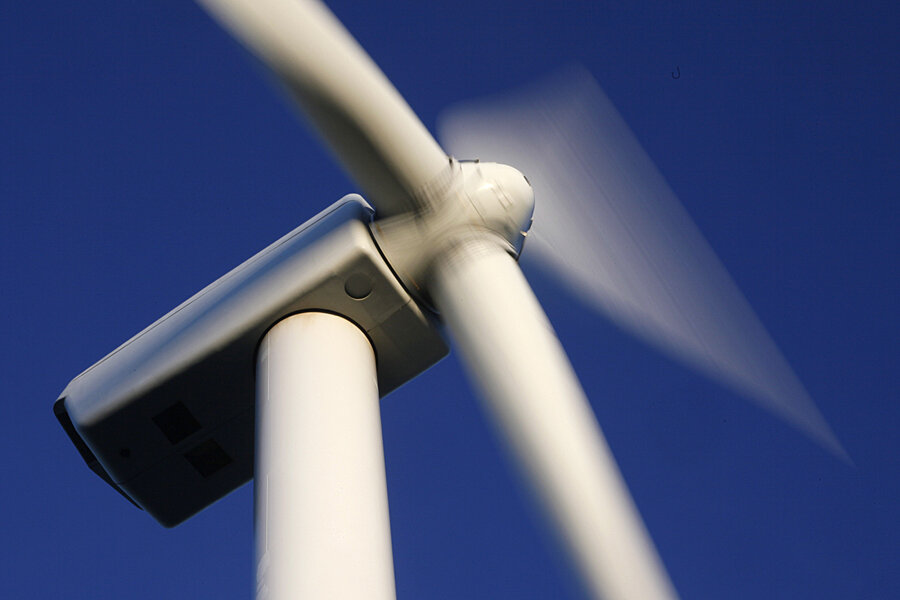Obama climate plan gives boost to US offshore wind
Loading...
| Washington
Hoping to copy the success of the onshore wind industry, the Obama administration is expanding efforts to develop offshore wind power projects. This week, it took two key steps:
- The Department of Energy announced Tuesday a conditional agreement to guarantee a $150 million loan for Cape Wind off the coast of Cape Cod in Massachusetts, which would be the country’s firs commercial-scale offshore wind facility. The “conditional commitment to the Cape Wind project demonstrates our intent to help build a strong US offshore wind industry,” Energy Secretary Ernest Moniz said in a release.
- On Wednesday, the Department of the Interior announced that nearly 80,000 acres off the coast of Maryland will be auctioned for wind development in August.
The renewed drive for offshore wind builds off the environmental momentum President Obama generated in early June, when the Environmental Protection Agency proposed 30 percent cuts to carbon dioxide emissions from existing power plants by 2030.
Offshore wind is a key component in the president’s Climate Action Plan, according to Charles Ebinger, senior fellow and director of the Energy Security Initiative at the Brookings Institution. “He wants to have an environmental legacy, and it fits very nicely into that,” Mr. Ebinger said in a telephone interview.
The US’s offshore wind industry has lagged behind countries like the United Kingdom, Germany, and Denmark, all of which have deployed a substantial number of wind turbines at sea. Land-based wind in the US grew dramatically between 2008 and 2012, under a wind production tax credit, but growth has slowed since the credit expired at the end of last year. According to the American Wind Energy Association, land-based wind accounted for about 4 percent of US electricity generation in 2013, with the ability to power over 15 million homes.
“By working with the industry, the Department has helped increase deployment of onshore wind while driving down costs by about 90 percent since the early 1980s,” Peter Davidson, executive director of the Energy Department’s Loan Programs Office, said in an e-mail statement. “We hope to replicate that success with offshore wind.”
Cape Wind is a crucial first step, but the project has drawn opposition from local residents who say the turbines would ruin views of a pristine habitat and endanger local wildlife.
“Business associations across Massachusetts have repeatedly sounded the alarm about the exorbitant costs associated with this outdated project and the negative impact it would have on businesses and consumers,” reads a statement this week from the Alliance to Protect Nantucket Sound, a group formed to oppose the project. “Instead of investing in unsustainable projects such as Cape Wind and Solyndra, we should focus our efforts and taxpayer dollars on innovative renewable energy projects that are economically and environmentally feasible.”
Federal support in the form of a loan guarantee increases the chance Cape Wind will come to fruition, Mr. Ebinger said, despite political battles and safety concerns that have beleaguered and delayed the proposed project for years. The Cape Wind facility would have a capacity of more than 360 megawatts, according to the Energy Department, enough to generate a majority of the electricity needed for Cape Cod, Nantucket, and Martha’s Vineyard. Its development is furthest along of any US offshore wind proposal.
Although offshore wind facilities tend to have higher capital costs – two to two and a half times the cost of their land-based counterparts, Ebinger said – offshore units in the US would have several perks.
“The resource is located close to the demand centers, up and down the Northeast and Mid-Atlantic coast,” said Christopher Long, manager of offshore wind and siting policy at the American Wind Energy Association. Offshore wind would also provide power from the east of the Atlantic seaboard, Mr. Long noted in a telephone interview, easing the bottleneck of power that reaches the coast from the west.
Long added that higher levels of offshore wind production are correlated with times of peak energy demand. In other words, there tends to be more wind at sea on hot summer days and during winter storms, when energy demand also spikes.
The Bureau of Ocean Energy Management, Regulation and Enforcement has so far awarded five commercial wind energy leases along the Atlantic coast, including the lease for Cape Wind. In addition to the August auction for space off the coast of Maryland, the agency expects to hold auctions for Massachusetts and New Jersey offshore leases in the next year.
“There are a number of projects in the advanced stages of development, and this is all a sign of the growing momentum for the industry,” Long said.





